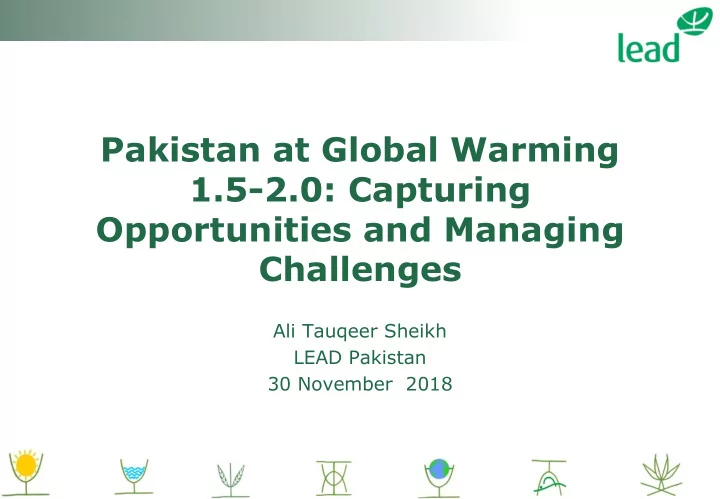

Pakistan at Global Warming 1.5-2.0: Capturing Opportunities and Managing Challenges Ali Tauqeer Sheikh LEAD Pakistan 30 November 2018
2
Non-overshoot Vs Limited- overshoot Most critical report in 30 years Granting 12 years for swift actions: 1.5 or 1.6 - No 2.0 The IPCC Special Report on 1.5 opts for a rigorous interpretation of the 1.5 limit on global warming It has good reasons to do so: "Overshooting" that target risks irreversible impacts and damage for societies and ecosystems, and increases reliance on unproven, high-risk geoengineering technologies 3
4
Food Security, Biodiversity, Ecosystem Health Expected reductions in crop yields, particularly in maze, rice, wheat, and potentially other cereal crops will harm food security. Biodiversity and ecosystems to suffer long-lasting & irreversible changes, including species loss and extinction, more so at higher temperature increases. Globally 18% of insects, 16% of plants, 8% of vertebrates will lose more than half of their range at global warming levels of 2°C. 5
Flood and Extreme Events 1/2 a degree of global warming could expose tens of millions more people worldwide to heat waves, water shortages and coastal flooding 2°C will expose about 37% of world population to severe heat waves, 411m more urban population to severe drought and 32-80m people to flooding from sea level rise in 2100 At 1.5°C, heat wave casualties can be reduced to 14%, rise in drought affected population to 350m & flood victims to 31-69m 6
Infrastructure and Renewable Energy Far-reaching transitions in energy, land, urban and infrastructure & industrial systems required Renewables are projected to supply 48-60% of electricity by 2030 and 63 – 81% by 2050 if warming is limited to 1.5 ° C. Steep reductions in the use of coal for electricity, close to 0% to limit global warming levels are predicted. Similarly, to limit warming 1.5 ° C, CO2 emissions from industry are projected to be 75 – 90% lower in 2050 from 2010 levels-clean technologies /production. 7
Sustainable Development Adaptation options specific to national contexts (with enabling conditions), will have benefits for sustainable development and poverty reduction Adaptation to climate change have robust synergies: health (SDG 3), clean energy (SDG 7), cities and communities (SDG 11), responsible consumption and production (SDG 12) and oceans (SDG 14). Potential tradeoffs with mitigation for poverty (SDG 1), hunger (SDG 2), water -SDG 6 & energy access -SDG 7 If poorly designed or implemented, adaptation projects can result in trade-offs or maladaptation with adverse impacts for sustainable development 8
Urban Areas New literature on urban climate change and its differential impacts on and risks for infrastructure sectors — energy, water, transport, buildings — and vulnerable populations Limited literature on risks of warming - 1.5 ° C and 2 ° C. Indirect risks may arise from interactions between urbanization and natural systems Future warming and urban expansion could lead to more extreme heat stress. At 1.5 ° C, twice as many megacities could become heat- stressed, exposing more than 350m more people to deadly heat by 2050 Without adaptation options, such as reflective roofs, land use, zoning & building codes, at 2 ° C warming, Karachi and Kolkata could expect annual conditions equivalent to the deadly 2015 heatwaves 9
Interacting and Cascading Risks Literature on compound, interacting and cascading risks at warming of 1.5 ° C and 2 ° C is limited Exposures approximately double between 1.5 ° C and 2 ° C, and land area affected by climate risks increases as warming progresses Asian and African regions are projected to experience 85 – 95% of global exposure with 91 – 98% of the exposed and vulnerable population, approximately half of which are in South Asia. Moderate and high multi-sector impacts are prevalent where vulnerable people live, predominantly in South Asia and China, at 1.5 ° C, but spreading to sub-Saharan Africa, Middle East, and East Asia at higher levels of warming. 10
Tipping point Warming of 1.5ºC Warming of 1.5ºC- Warming of up to or less 2°C 3°C Heat-waves, Substantial increase Substantial increase Substantial increase unprecedented in occurrence of in potentially in potentially heat and human potentially deadly deadly heat-waves deadly heat-waves health heat-waves likely likely very likely Annual occurrence More than 350 of heat-waves million more similar to deadly people exposed to 2015 heatwaves in deadly heat by India and Pakistan 2050 under a midrange population growth scenario 11
CLIMATE RISKS INCREASE FOR PAKISTAN AT 1.5 AND WORSEN AT 2 DEGREES & BEYOND 12
Pakistan’s Changing Climate Patterns Pakistan Meteorological Department: Each successive summer since 2010 has been the hottest recorded A shift in the seasons of at least 15 days has been observed Over the past 20 years, summer was beginning earlier and winter later than average with increasingly frequent and intense heatwaves 13
Climate Change & Pakistan’s SDGs Challenge Vision 2025: By 2030 per capita income: US$ 8,180 OECD Projection: SSP 1: US$ 8,233 SSP 2: US$ 6,526 If Paris Agreement is not implemented, SDGs will slip 14
The Cost of Disasters is a Threat to SDGs Targets WB, MOF, NDMA and SECP estimate Annual Economic Impact of Flooding between US$ 1.2 and 1.8 b (equivalent to 0.8 % of GDP) – Big floods will cost 15.5 b (around 7% of GDP / 40% of federal budget) WB estimates Rs. 1 / 2 b a day as Environmental Cost to the Economy UNDP, MOCC & LEAD study estimates that the Annual Cost of Adaptation is from US$ 2-3.8b 15
The Cost of Disasters is a Threat 16
Evolving Approaches to Adaptation Mainstreaming Adaptation linked Locally specific adaptation; to sustainable sectoral approach sectoral approach development; Cross-sectoral and transboundary approaches 17
Vision 2025/ Development Strategies Low Carbon Climate Resilient Development Development Climate Compatible Development Mitigation Strategies Adaptation Strategies Co- Benefits 18
Recommend
More recommend